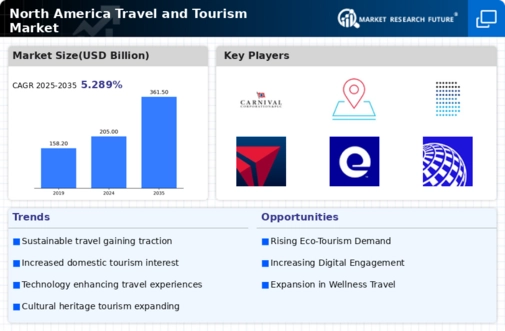Diverse Travel Offerings
The Global North America Travel and Tourism Market Industry is characterized by a wide array of travel offerings that cater to diverse consumer preferences. From adventure tourism to cultural experiences, the variety of options available attracts a broad demographic. For instance, the rise of wellness tourism has gained traction, with travelers seeking health-focused retreats and experiences. This diversification not only enhances consumer choice but also stimulates market growth. As the industry evolves, it is anticipated that new niches will emerge, further enriching the travel landscape and contributing to the market's expansion.
Rising Disposable Income
The Global North America Travel and Tourism Market Industry benefits from an increase in disposable income among consumers. As individuals experience higher earnings, they are more inclined to spend on travel and leisure activities. This trend is particularly evident in the United States and Canada, where the average household income has seen a steady rise. In 2024, the market is projected to reach 235.94 USD Billion, reflecting this growing consumer spending power. The correlation between disposable income and travel expenditure suggests that as financial conditions improve, the demand for travel services will likely escalate, further propelling the market's growth.
Market Growth Projections
The Global North America Travel and Tourism Market Industry is poised for substantial growth, with projections indicating a market size of 541.32 USD Billion by 2035. This growth is underpinned by a compound annual growth rate (CAGR) of 7.84% from 2025 to 2035. Such figures suggest a robust recovery and expansion trajectory for the industry, driven by increasing consumer demand, technological advancements, and evolving travel preferences. The anticipated growth reflects the resilience of the market and its ability to adapt to changing consumer behaviors and economic conditions.
Technological Advancements
Technological innovations play a pivotal role in shaping the Global North America Travel and Tourism Market Industry. The proliferation of mobile applications and online booking platforms has transformed how consumers plan and book their travel. Enhanced user experiences, coupled with the integration of artificial intelligence and machine learning, streamline the travel process. For instance, personalized travel recommendations and real-time updates on travel itineraries have become commonplace. These advancements not only improve customer satisfaction but also drive operational efficiencies for travel providers. As technology continues to evolve, it is expected to further enhance the market's growth trajectory.
Sustainable Tourism Practices
The Global North America Travel and Tourism Market Industry is increasingly influenced by the growing emphasis on sustainable tourism practices. Travelers are becoming more conscious of their environmental impact, leading to a demand for eco-friendly travel options. This shift is prompting businesses to adopt sustainable practices, such as reducing carbon footprints and promoting local cultures. For example, many tour operators are now offering eco-tours that highlight conservation efforts. As sustainability becomes a priority for consumers, the market is likely to see a rise in demand for responsible travel options, which could contribute to its projected growth.
Government Support and Investment
Government support and investment play a crucial role in the development of the Global North America Travel and Tourism Market Industry. Initiatives aimed at promoting tourism, such as infrastructure development and marketing campaigns, are essential for attracting visitors. For example, various states in the U.S. have launched tourism boards to enhance regional visibility and appeal. This proactive approach is expected to bolster the market, with projections indicating a growth to 541.32 USD Billion by 2035. Such investments not only improve the travel experience but also create jobs and stimulate local economies, reinforcing the industry's significance.
























Leave a Comment